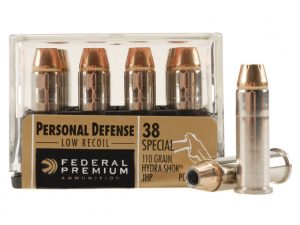The Best .45 ACP Ammo for Range Training
The .45 ACP is perhaps the most iconic of all pistols on the market today. It was designed by firearms legend John M. Browning for Colt’s Patent Firearms Manufacturing Company in 1905. The round was tested over a period of six years alongside the Colt M1911 pistol. Both excelled during strict military testing and were quickly adopted by the U.S. military as a standard issue equipment, replacing the .38 Long Colt. The M1911 is the longest-standing military and law enforcement handgun in the world.
The .45 ACP was immediately lauded as the best ammo on the market and was also chosen by the U.S. Cavalry and the U.S. Army. The military used .45 ACP handguns as official sidearms throughout WWI and WWII. They were issued until they were replaced by 9mm semi-autos in 1985.
The .45 ACP has had a regular presence in the history books. It was used in many military conflicts including Iwo Jima, Normandy, Korea, and the Tet Offensive. It was used extensively at the St. Valentine’s Day Massacre and was a favorite of outlaws Bonnie & Clyde and John Dillinger.
The .45 ACP on the Shooting Range
The .45 ACP is a favorite for range training with amateurs as well as competition shooters. Known for its high accuracy and deep penetration, the .45 ACP is known as a high performance round. It is also preferred by those that like to reload their ammunition or create wildcat rounds, loading their own ammo instead of relying on factory rounds.
Choosing Ammunition
Range training generally has its own set of rules, just like competitions. While governing bodies of most shooting competitions will not recommend specific types or brands of ammunition, they do have guidelines. When choosing ammo for the range, it is best to seek the advice of someone who is accustomed to shooting your specific ammo. Have fun target shooting with different guns as well as a variety of ammo.
Reliability
Shooters require reliable rounds, so choosing the right ammo for your gun is crucial. Try shooting various bullet weights and brands.
Consistency
Consistency is another important aspect of choosing the correct ammo. Range training is the perfect place to test different types of .45 ACP ammo to gauge what will work best for you and your gun.
Cost
Shooters who spend a significant amount of time on the range can go through hundreds of rounds in a short period of time. Buying ammo online is an easy way to save money. Also consider trying different brands or sampling bulk or surplus ammo. Serious shooters may want to consider reloading rounds.
Testing .45 ACP Ammo
The only way to test ammo is to shoot a couple hundred rounds. There are specific protocols used to test ammunition, even if you don’t feel the need to learn about each type’s ballistics. The data collected during this type of test will help you down the road with making the right choice for ammo, whether you’re a competition shooter, law enforcement, or target shooting on the weekend.
The following is common criteria for collecting ballistics data:
- Shoot from 10 feet away, which is the average distance in defense situations.
- Using 4 layers of heavy fabric in front of ballistics gel to simulate real life situations.
- Ideal penetration is 12-18 inches, enough to do damage without the risk of over-penetration.
- Make 5 shots with each brand of ammunition to establish an average.
Consider using a compact pistol with a smaller barrel, if you plan to carry concealed. However, a longer barrel will provide greater numbers for muzzle velocity. This information will help you to understand things like penetration and muzzle velocity, as well as how to compare different bullet weights and calibers.
The Best .45 ACP for Range Training
Federal Ammunition: American Eagle 230 Grain FMJ
Federal Ammunition is always at the top of the list for range training. It produces a 230-grain .45 ACP cartridge with a full metal jacket, non-magnetic lead core, and non-corrosive Boxer primer. The brass can be reloaded up to five times, which makes it an affordable choice. The American Eagle .45 ACP is Federal’s newest production ammo, featuring clean-burning powder and ballistics like Federal’s Premium Personal Defense rounds. It is an ideal for practice shooting purposes.
Federal American Eagle Non-Toxic Primer 45 ACP 230 Grain TMJ
Federal’s American Eagle line has a solid reputation for manufacturing quality ammo at a reasonable price. This 230-grain TMJ was made specifically for range training. TMJ bullets fully encase the lead core to include the base of the bullet. They primers are free from toxic metals. It has a muzzle velocity of 890 fps, which is similar to their 230-grain JHP loads. It’s a great product to carry in your range bag.
Federal Classic Hydra–Shok Persona Defense
This 230-grain round has been on the market for a long time. The bullet is made with a central lead post to aid in jacket expansion while keeping the bullet intact. This allows the bullet to give consistent performance and is preferred by agencies like the FBI.
Federal Ammunition Personal Defense
Federal Ammunition Company produces a 230 grain jacketed hollow point (JHP). It is often called the best large caliber for self-defense regarding to accuracy, precision, and penetration while maintaining close to 100% weight retention.
Hornady Ammunition Duty Defense JHP
Hornady manufactures this 220-grain, .45 ACP +P ammo is an FTX that offers ultimate stopping power. It has similar characteristics of Hornady’s cartridges, offering accuracy, precision, and penetration with maximum expansion.
Magtech Ammunition FMC
Magtech Ammunition has been manufacturing ammo since 1926. They produce all components used in their ammo including the powder, primer, and projectiles. The company’s strict quality standards ensure this 230-grain round will be reliable. Magtech’s reputation and high quality ammo have put them at the forefront of the industry.
Speer Ammunition Gold Dot JHP
Speer’s Gold Dot has an outstanding reputation for delivering clean products. This 230-grain jacketed hollow point (JHP) is an accurate round that gives controlled penetration that’s powerful enough to stop any threat.
Winchester Service Grade .45 ACP 230 Grain FMJ
Winchester is one of the oldest manufacturers in the country for good reason – they consistently deliver quality ammunition. Winchester Service Grade 230-grain FMJ is intended for those who spend a lot of time at the range and demand a reliable, clean-burning target ammo. They use new brass and Boxer primer to offer a highly accurate round to last you through your time at the range or throughout the competition.
Conclusion
Target shooting and range training are activities that can help you improve your skills while having fun with friends and family. Knowing which ammunition to use only enhances the experience as you hit the bullseye each time. To learn more about the .45 ACP check out this guide on “The Best .45 ACP Ammo For Self-Defense, Target Shooting, and More.”

